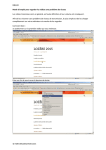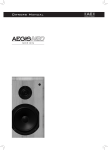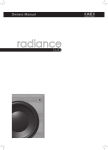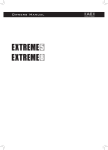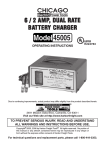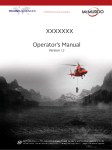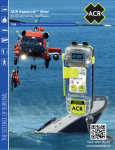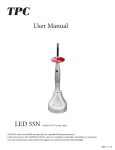Download ARG 5410 MKII SARSAT Beacon Tester User Manual Issue 2
Transcript
ARG 5410 MKII SARSAT Beacon Tester ARG 5410 MKII SARSAT Beacon Tester User Manual Issue 2 1 5410-EQ001-HB1.doc © A·R·G ElectroDesign Ltd. 2004 ARG 5410 MKII SARSAT Beacon Tester Contents 1: Introduction This chapter identifies the main functions of the unit; provides a summary of its main features and a physical overview. 2: Operating the unit This chapter provides a clear illustrated description of all the menus and their individual functions. 3: Updating the unit This chapter briefly describes how to update the units software for current country code listings and general software updates 4: Safety, EMC and Approval This chapter provides information on relevant safety requirements when using the ARG 5410MkII. 5: Servicing, Warranty and Contact Information This chapter provides information on in and out of warranty repairs; technical assistance, and contact information. 2 5410-EQ001-HB1.doc © A·R·G ElectroDesign Ltd. 2004 ARG 5410 MKII SARSAT Beacon Tester CHANGE HISTORY Issue Date 1 2 01/04/04 19/07/04 DCN/ECN Change Information on updating the unit 3 5410-EQ001-HB1.doc © A·R·G ElectroDesign Ltd. 2004 ARG 5410 MKII SARSAT Beacon Tester 1. Introduction 1.1 Overview COSPAS-SARSAT beacons are battery powered devices capable of initiating an alert by transmitting a distress message via satellite on the frequencies 406.025MHz and/or 121.5MHz. 121.5MHz beacons employ a swept tone amplitude modulation, whereas 406MHz beacons transmit a short burst of phase modulated power repeated at approximately 50 second intervals. Most 406MHz beacons also include a low power 121.5MHz swept tone transmitter, intended to act as a homing signal for rescue forces. The following terms are also used to describe these distress transmitters: EPIRB: ELT: PLB: Emergency Position Indicating Radio Beacon - generally used for beacons intended for marine use. Emergency Locator Transmitter - usually refers to a beacon carried by aircraft, and may be activated by a crash detection switch. Personal Locator Beacon - used by COSPAS-SARSAT to denote a beacon intended for land mobile use. This term is also used for beacons carried by aircrew. The COSPAS-SARSAT system can provide the rescue forces with the location of the beacon, based on the apparent frequency shift of the signal as received by the moving satellite (the Doppler effect). In addition, each 406MHz transmission contains a coded message which can uniquely identify the beacon, and may provide additional information such as method of activation, nature of distress etc. A number of different protocols are used, depending on the type of user and the national regulations guiding the use of the beacon. 4 5410-EQ001-HB1.doc © A·R·G ElectroDesign Ltd. 2004 ARG 5410 MKII SARSAT Beacon Tester The ARG 5410 MkII is designed to provide independent reassurance that a beacon designed to operate via the COSPAS-SARSAT system is functional, and correctly encoded. The unit responds to the signals radiated by most beacons during their "self-test" mode. Alternatively, the beacon may be operated in a full functional mode, but in this case a radio screened enclosure must be used, or a direct connection made between the antenna terminals of beacon and tester, to ensure that no signal is radiated which may be mistaken for a genuine alert. The tester is capable of checking that the frequency of the transmitted 406MHz signal is within tolerance, and of giving an independent check of the beacon coding. It cannot perform an exhaustive parametric check, however, to guarantee satellite compatibility, and is therefore no substitute for the proper type approval and quality control procedures required. A short test can also not give a full assurance as to whether the beacon would activate correctly in an emergency, and for how long it would continue to operate. 5 5410-EQ001-HB1.doc © A·R·G ElectroDesign Ltd. 2004 ARG 5410 MKII SARSAT Beacon Tester 1.2 Main Features The ARG 5410 MkII is compliant with the appropriate sections of the IMO requirements for test equipment and can provide the following features: • Receives and decodes all types of COSPAS and SARSAT beacon signals • Audible indication of 121.5 MHz operation • Radiated signal or 50ohms direct input option (via 30dB pad) • Serial data output to printer or PC • Independent check of serial number and call sign • Measures 406 MHz carrier frequency • Easily updatable software / database of country codes • ‘Long message’ and location protocols included • 121 and 406 MHz Power measurement • Large backlit LCD screen • Re-chargable battery • Integral serial output • Mains Charger • Splash proof carrying case 6 5410-EQ001-HB1.doc © A·R·G ElectroDesign Ltd. 2004 ARG 5410 MKII SARSAT Beacon Tester 1.3 Physical Overview 7 5410-EQ001-HB1.doc © A·R·G ElectroDesign Ltd. 2004 ARG 5410 MKII SARSAT Beacon Tester 2. Operating the unit The unit is switched on or off by using the slide switch on the top panel, just above the data connector. On initial switch on, an opening screen will be shown, that includes the software version loaded. After two seconds, this will be replaced by the Select Menu as illustrated below: 2.1 Charging the battery The ARG540 MkII has an internal battery which will need to be recharged before using the tester for the first time. A wall mounted power supply unit is supplied with the tester to allow this to be done from a suitable mains outlet. This power supply is connected directly to the tester. (See fig. 1.) Contact your supplier if the power supply is not compatible with your mains outlet. The 2-pole jack plug on the mains power supply should be firmly plugged into the socket at the base of the tester, ensuring that it is all the way in. Fast charge circuitry in the tester will allow it to be used after less than 30 minutes connection to the charger, but for a full charge the unit should be left connected overnight. For maximum battery life, the unit should not be left on charge for longer than 24 hours at a time. The unit should not be used when the charger is plugged in. Fig 1. 8 5410-EQ001-HB1.doc © A·R·G ElectroDesign Ltd. 2004 ARG 5410 MKII SARSAT Beacon Tester N.B. The mains power supply has a two-piece output connector which is factory fitted to give the correct polarity for the ARG 5410 MkII. Removal of this connector is not advised as damage may occur to the connector and/or the ARG 5410 MkII. Disposal of Batteries (Nickel Metal Hydride) A Nickel Metal Hydride (Ni-MH) battery pack is used in this unit. Do not attempt to open, disassemble or mutilate the battery pack, and do not short circuit the battery pack terminals. If the battery pack has leaked or vented, it must be replaced immediately. Replace only with an identical battery from the same manufacturer or with a type recommended by ARG ElectroDesign Ltd. Please ensure the power lead is removed before removing the battery pack. The battery pack contains a smart charge management system and must only be charged using the supplied charger. European legislation (EC Directive 91/689/EEC) classifies Ni-MH batteries as hazardous waste due to the nickel content. Collect spent batteries separately for disposal, do not mix with other waste streams. Contact your local battery supplier for up to date information on the collection, disposal or recycling procedures for your country. 9 5410-EQ001-HB1.doc © A·R·G ElectroDesign Ltd. 2004 ARG 5410 MKII SARSAT Beacon Tester 2.2 Menu Structure 10 5410-EQ001-HB1.doc © A·R·G ElectroDesign Ltd. 2004 ARG 5410 MKII SARSAT Beacon Tester 2.3 Recv Menu Recv switches on the 121.5/406MHz receiver/demodulator, and brings up the following screen: The receiver/demodulator will immediately switch on. If a homing signal is detected (121.5MHz), the swept tone modulation will be heard. Note that most beacons do not transmit a homing signal during self-test. Those that do only transmit for a short time (less than one second). To avoid any possibility of this signal causing an alert, testing of beacons found to radiate on 121.5MHz during self-test should limited to the first five minutes of any hour, unless a shielded enclosure is used. The 406MHz signal is normally transmitted as a short duration (about half a second) burst. In self-test mode, most new beacon designs transmit a normal length burst, but with a special framing code which prevents satellite detection. Older designs, in particular, may do any of the following during Self Test: a) Transmit an unmodulated burst. b) Transmit a burst with a non-standard garbled message. c) Not transmit at all. In these cases, it will be necessary to test the beacon in a shielded enclosure in operational mode. 11 5410-EQ001-HB1.doc © A·R·G ElectroDesign Ltd. 2004 ARG 5410 MKII SARSAT Beacon Tester Shows "Carrier detected" if a 406MHz burst is present, followed by 406.0250 MHz PASS and 406 power reading Shows "121.5MHz detected" if a a homing signal is present, followed by 121.5 power reading At the end of the 406MHz burst, "Unmodulated signal" will be shown if no data is detected. "Bad Frame" will be shown if the receiver is unable to detect valid normal or self-test framing codes. Otherwise the framing type NORMAL or S'TEST will be shown followed by OK or BAD according to whether any errors were found in the message, and the 15-hex ID code will be shown. This display is shown for 5 seconds. For unmodulated signal or bad frame, the unit will return to "waiting for signal". Otherwise it will go back to the select menu. For a valid error-free message NORMAL OK or S'TEST OK, the message will be saved in memory, for recall using the VIEW option. 12 5410-EQ001-HB1.doc © A·R·G ElectroDesign Ltd. 2004 ARG 5410 MKII SARSAT Beacon Tester 2.4 View Menu The view menu allows you to view successfully decoded messages from previous readings. The data that is shown here varies enormously, but, per message there are normally 4 screens of information. These can be viewed by using the arrow key to navigate through the screens. Up to 30 messages can be stored, however if you exceed this number the oldest message will be deleted, and will result in messages being re-numbered. You can scroll through these screens by using the right arrow (F3) key. To see the same screen on an earlier message, press the up arrow (F1) key. To see the same screen on a later message, press the down arrow (F2) key. To jump to the first message (MESG#1), press the F key. To jump to the last message stored (up to MESG #30), press the L key. 13 5410-EQ001-HB1.doc © A·R·G ElectroDesign Ltd. 2004 ARG 5410 MKII SARSAT Beacon Tester MESG # Printer port settings Baud 2400 8 Bit No Parity X on X off Where 1 is the oldest message. This can go up to 30. Deleting a message renumbers all later messages. DELETE removes the current message. ENTER prints the current message. RECEIVED AT FRAMING shows time/date of message NORMAL or S'TEST, followed by OK or BAD according to whether the BCH error check code is valid. ID BEACON TYPE shows 15-hex ID EPIRB, ELT, PLB, or TEST. Followed by MANUAL, AUTOMATIC, "+Ext GPS" or "+ Int GPS shows 406MHz frequency followed by PASS or FAIL. Limits 406.020 - 406-030 MHZ FREQUENCY 14 5410-EQ001-HB1.doc © A·R·G ElectroDesign Ltd. 2004 ARG 5410 MKII SARSAT Beacon Tester 406 Power COUNTRY CALLSIGN 30 HEX ID Homing Other info Long Mesg POS shows a number indicating received signal strength 3 digit code followed by up to 7 characters (if found in database) Options depend on beacon type and protocol use: Maritime (EPIRBs) could show trailing six digits of MMSI followed by beacon number - e.g. Callsign: 233000 2 (i.e. Beacon No. 2) or could show Callsign: IE2532 (example of Irish callsign), or could show Ser #25640(3/1064) (example of UK serialised coded EPIRB serial number 25640 interpreted as model no.3, sequence no. 1064) Aircraft beacons (ELTS) might show "AIRCRAFT# 2D5E66" (example of 24-bit aircraft address), or "Ser # 254609", or "Registr.No: FR56289" (example of aircraft tail number), Or "Operator: EZY No. 3456" (example of aircraft operator/serial number). PLBs generally use a serial number, e.g. "Ser #23456" shows number representing the full message before decoding - bits 26-144 (26-112 for short message) 121.5 MHz, 9GHz SART, or None 121.5 Power (if detected) - again a number representing received signal strength Some beacons have the COSPAS-SARSAT type approval number in the message. This would be shown as "C/S #103" USA serialised beacons have additional information, e.g. "Model 1 ProdRun 2" If not self-test, the 2nd BCH error check will be tested, shown as "Long Mesg OK" or "Long Mesg BAD" Transmitted position data, shown in the format: DD MM SS ‘N’ or ‘S’ DD MM SS ‘E’ or ‘W’ Invalid or default position shown as ***** N.B. Default position is normally transmitted during SELF TEST. 15 5410-EQ001-HB1.doc © A·R·G ElectroDesign Ltd. 2004 ARG 5410 MKII SARSAT Beacon Tester 2.5 Setup Menu This menu allows you to set the time, date / year, adjust the contrast of the display and upload new versions of software when available. 2.6 Quit Pressing the F4 key causes the opening menu to be shown again before reverting to the Select menu. To switch the unit off, use the slide switch on the top panel, just above the serial data connector. 16 5410-EQ001-HB1.doc © A·R·G ElectroDesign Ltd. 2004 ARG 5410 MKII SARSAT Beacon Tester 3. Updating the unit 3.1 Updating software versions Within the set-up menu you can update the software version of your unit. The update menu can be found on the 2nd page of “Setup”. If you enter this menu you will find a screen similar to the one below: Press the “u” button to upload new software, but please be aware that this function will erased all previously stored data. 17 5410-EQ001-HB1.doc © A·R·G ElectroDesign Ltd. 2004 ARG 5410 MKII SARSAT Beacon Tester 4. Safety and EMC Approval 4.1 IMO Approval ARG5410 meets and exceeds the following IMO requirements for test equipment for annual testing and shore-based maintenance of EPIRBs: SOLAS Chapter IV, paragraph 15.9 MSC Circular 1039 MSC Circular 1040 4.2 Safety and EMC Specifications Safety The unit are designed to comply with the requirements of EN60950: 1998 Amendments 1 to 5 UL1950 Third Edition 1995 CSA 22-2: 950-95 EMC The units are CE marked, and have been tested against the following specifications EN55022 1994 Class A EN 50082 1992 89/336/EEC (Europe) 47CFR CH.1 (FCC) Part 15, Subpart B, Class A 18 5410-EQ001-HB1.doc © A·R·G ElectroDesign Ltd. 2004 ARG 5410 MKII SARSAT Beacon Tester 5. Warranty, Servicing and Contact Information 5.1 Warranty The ARG 5410 MkII is warranted against failure due to poor workmanship or defective materials for a period of two years from date of delivery. Extended warranties are available. Any evidence of unauthorised access to the internal parts will be regarded as invalidating this warranty. All external features, and in particular the unit should be kept free from damage or undue ingress of water, dirt, grease, solvents or other contaminates at all times. Claims against this warranty will be treated on an individual basis and will not be upheld if there are signs of accidental damage, intentional damage, mistreatment or if the unit has been stored or operated outside its intended temperature range. 5.2 Repairs and Calibration A·R·G have an agreement with DHL to offer a turnkey solution to overseas users of our equipment. Any equipment that needs to be returned to A·R·G for periodic re-calibration or repair can now be returned using our Import Express Account. Customers can arrange pickup locally using our account. The equipment will be returned to A·R·G and re-exported after completion. This process described above improves turn-around times and reduces the risk of problems with Customs, such as added costs, or delays due to improper paperwork. If units are returned by an alternative method, this may result in your equipment being returned by your carrier, without reaching A·R·G. 19 5410-EQ001-HB1.doc © A·R·G ElectroDesign Ltd. 2004 ARG 5410 MKII SARSAT Beacon Tester 5.3 ARG Contact Information For servicing or warranty returns, please contact: Service Department A·R·G ElectroDesign Ltd Querns Business Centre Whitworth Road Cirencester Gloucestershire GL7 1RT United Kingdom Telephone: Fax: Email: +44(0)1285 658501 +44(0)1285 885376 [email protected] For all other enquires, please contact: [email protected] [email protected] [email protected] 20 5410-EQ001-HB1.doc © A·R·G ElectroDesign Ltd. 2004




















